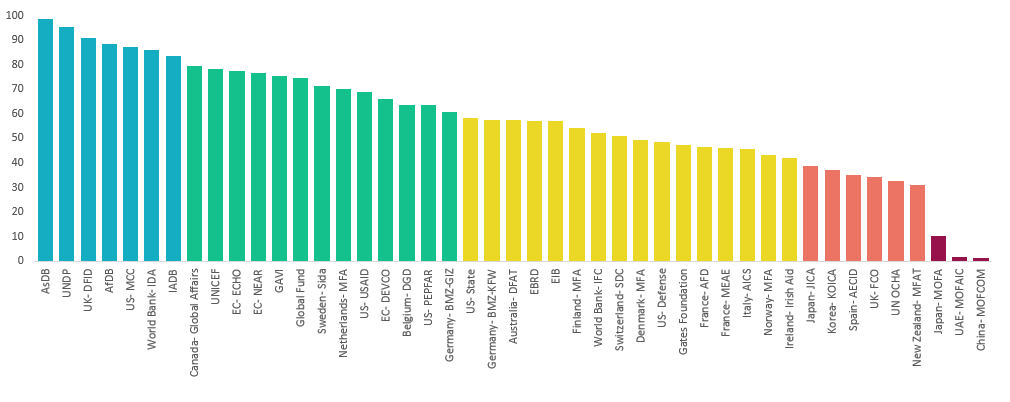Looking Ahead to the Next Aid Transparency Index
At Publish What You Fund, we have been getting a number of enquiries about when the next Aid Transparency Index will be produced, as well as who will or won’t be included. We are really encouraged by the amount of interest in this, not least because we remain convinced that the Index contributes to increased transparency among the world’s leading international development donors.
This is what we can tell you already
We can confirm that the next Index will be in 2020. This means that we expect data collection to start at the end of 2019 so that we can launch the 2020 Index in the spring or summer of 2020.
We do not plan to increase the number of donor agencies included, so there will be approximately 45 organisations again in 2020. We will review the selection criteria and announce over the summer which organisations will be included. We do not expect to make any major revisions to the methodology.
Things to bear in mind
But we are not standing still. We have been considering our findings from last time:
What went well?
One of the main ingredients of this success has been the level of engagement we have with donor agencies during the data collection period of the Index. The Index is much more than a simple assessment. For example, we saw that the donor agencies included in 2018 improved both the comprehensiveness and quality of their publication between the start and end of data collection as a result of our feedback and engagement. They published comparable data on more indicators after the first round of sampling results and, on average, indicators passing sampling went from 58% to 71% during this time (more details are available in our blogs here and here).
We were pleased to see that a range of aid and development actors, regardless of their business model, performed well in 2018. This was particularly true for those organisations that made transparency an organisational priority and integrated it across teams. For example, multilateral development finance institutions accounted for four out of the seven agencies in the Index’s ‘very good’ category and included the top performer, the Asian Development Bank. This also applies to humanitarian agencies: ECHO, the EC’s agency for European Civil Protection and Humanitarian Aid Operations, ranked ‘good’, coming second only to DFID among all EC agencies and EU member states in the Index.
 We also saw unprecedented amounts of timely aid and development data being made available in open and comparable formats with 75% of organisations assessed in the 2018 Index now publishing on a monthly or quarterly basis.
We also saw unprecedented amounts of timely aid and development data being made available in open and comparable formats with 75% of organisations assessed in the 2018 Index now publishing on a monthly or quarterly basis.
What needs to improve?
However, some areas need improving and we will be paying particularly close attention to these for the 2020 Index:
More data does not necessarily mean ‘better’ data. We noticed that some problems with published data, even basic ones, persist. Notably, many donors still need to pay attention to getting the basics right. More than a quarter of organisations assessed in 2018 did not provide activity descriptions that could be understood by non-experts. In some cases, no descriptions or titles were given at all. This may seem trivial to some, but if this information is either meaningless or can’t be found by outside users, then it is harder for that information to be used for better development outcomes.
This is just one example of a poorly worded title that we found:
In addition, performance-related information, those pieces of information that are critical if you want to assess project and donor impact, such as objectives, results and evaluations, were the most difficult to find in 2018 – if they were available at all. Collectively, donors scored only 27% on average for the performance component, and the relevant indicators (pre-project impact appraisals, results and evaluations) were the three least published indicators overall. This makes it particularly hard for anyone to be able to effectively monitor or learn from the experiences of the majority of projects that donors resource.
We shared more information about this and what donors should do in our blogs here and here, and we will continue to push donors to do better.
Looking ahead to 2020
As we shake off 2018 and start to gear up for the 2020 Index towards the end of this year, we congratulate those donors that worked hard on their transparency and did well in the 2018 Index. But we hope that all donor agencies, whether they are in the Index or not, resolve to prioritise improving the quality of their data and provide the information that users want this year. This includes performance-related information and just getting the basics right.
We encourage donor agencies to start getting their data in better shape now before data collection begins at the end of this year. We have developed a number of free to use tools that can help. We made the data quality tester (DQT) available before the last Index to allow organisations to test the quality of their data before publishing to IATI. More recently, we also launched IATI Decipher. For the first time, this enables users to quickly visualise all of an organisation’s strategic data on the IATI Registry web pages, making previously incomprehensible information now accessible for users. If donor agencies can do that, then we look forward to having even better news to share in 2020.


